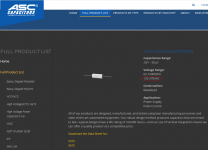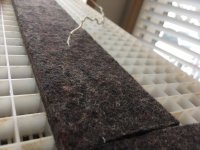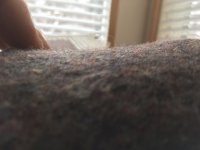Hi Andy
You said once... "If the felt pads show any signs of becoming detached from the panel, they should be completely removed and reglued with a contact adhesive applied to the felt (only!)."
I just wanted to check if you meant to cover the whole face of the felt pads, or in a grid pattern to match the egg crate?
Regards
Grant
You said once... "If the felt pads show any signs of becoming detached from the panel, they should be completely removed and reglued with a contact adhesive applied to the felt (only!)."
I just wanted to check if you meant to cover the whole face of the felt pads, or in a grid pattern to match the egg crate?
Regards
Grant
Aligning the glue stripes to where they need to go on the egg crate would be almost impossible I would think. I'd say just spray the whole pad and stuff it on. Any extra glue will just attract dust and keep it off the mylar.
Aligning the glue stripes to where they need to go on the egg crate would be almost impossible I would think. I'd say just spray the whole pad and stuff it on. Any extra glue will just attract dust and keep it off the mylar.
Thanks 4H, that makes sense.
Cheers
Grant
I'm still trying to get my head around the mechanics of how the felt pads help with resonance. Can you explain? No one's been able to so far. Wouldn't a layer of glue on the face compromise their efficacy? I have Acoustats and I can clearly see the pads do not have glue except for exactly where they stick to the louvers. So it's obvious they used a brush or a roller to apply glue to the louver and then applied the felt. It seems the felt requires it's inherent porous damping characteristic to be effective. I get that the remaining surfaces may compensate but that's just what my query is.Aligning the glue stripes to where they need to go on the egg crate would be almost impossible I would think. I'd say just spray the whole pad and stuff it on. Any extra glue will just attract dust and keep it off the mylar.
I would expect that the felts would act as resistance to air movement, especially at larger excursions, since the air has a limited curtain area perpendicular to its original direction of motion from which to escape. I don't think the glue between the louvres would have much of an added effect. I think bolserst produced graphs of resonance tests way earlier in this thread that showed just how effective a compromise the felts were and how much better they were than using nothing or masking/packing tape.
I came across these on eBay which look like suitable 0.01uF/6kV replacements: 0.01uF 6000V ASC High Voltage Poly Capacitor 6KV .01uF lot of 4 | eBay
My only concern is that they're listed as "used."
My only concern is that they're listed as "used."
Perhaps a bigger concern is poly-what? The eBay auction doesn't say, and the ASC website doesn't yield anything on "ANA14". ASC is American Shuzuki Corp, who did make caps for Acoustat, but these don't look familiar.
If you are desperate to find replacements for capacitors that have failed, these should work. If you are looking to upgrade or replace caps that are okay but "old", I would steer clear of these because you have no idea what you're getting.
If you are desperate to find replacements for capacitors that have failed, these should work. If you are looking to upgrade or replace caps that are okay but "old", I would steer clear of these because you have no idea what you're getting.
I'm still trying to get my head around the mechanics of how the felt pads help with resonance. Can you explain? No one's been able to so far. Wouldn't a layer of glue on the face compromise their efficacy? I have Acoustats and I can clearly see the pads do not have glue except for exactly where they stick to the louvers. So it's obvious they used a brush or a roller to apply glue to the louver and then applied the felt. It seems the felt requires it's inherent porous damping characteristic to be effective. I get that the remaining surfaces may compensate but that's just what my query is.
Glue was applied directly to the felt over it's entire surface with a spray gun. Being a contact adhesive, the glue was allowed to get tacky and then applied to the louver. Only a very thin layer was applied, so it may not be visible between the grids.
The felt pads help by adding some acoustic resistance(ie resistance to air motion) near the diaphragm to provide damping. This works with ESLs because the air is the primary load on the diaphragm at low frequencies. With dynamic woofers where the primary load is the mass of the voice coil and cone, adding acoustic resistance has little effect.I'm still trying to get my head around the mechanics of how the felt pads help with resonance.
The thin layer of glue acts like a thin porous diaphragm placed next to the felt. It won’t change the LF damping, but if applied too thickly it could start to add in some HF reflections similar to what was seen with the packing tape. See Post #1529.…I don't think the glue between the louvres would have much of an added effect. I think bolserst produced graphs of resonance tests way earlier in this thread that showed just how effective a compromise the felts were and how much better they were than using nothing or masking/packing tape.
Note that the 6kV rating is for DC not AC. The application in the Acoustat mixer circuit requires an AC voltage rating of about 3kVrms. Unless these capacitors are specifically made for that(either oil impregnated or internally sectioned) they will eventually fail due to internal corona slowly eating away at the metal film. Note that the ASC website identifies their HV capacitors as having an AC voltage rating < 300Vrms. Attached is an article by ASC describing the corona limit.I came across these on eBay which look like suitable 0.01uF/6kV replacements:
An alternative to a special built capacitor is to use a series combination of capacitors to reach the required limit.
In case you missed it, I had posted an example using WIMA caps. in Post #1579
Attachments
Thanks bolserst, it certainly seems ASC's current production doesn't permit AC voltages above about 300V, but ANA14 looks like a discontinued product. Definitely not worth the risk with better options available. However, they could be used for the Izzy-Wizzy smoothing cap mod for the bias multiplier.
Okay, this is a panel I chose at random to pull back the felt(I have quite a few), original untouched. I've looked at others and they are identical. You can see there is no layer of glue on it. In the other pic if you look carefully, you will see the glue on the louver extending a little past the width of the felt. It's rough and unglossy there from the glue. I have a complete set of panels for the X, a complete set for Model 3, and a complete set for Monitor 3, total of 18 panels. They are all the same.Glue was applied directly to the felt over it's entire surface with a spray gun. Being a contact adhesive, the glue was allowed to get tacky and then applied to the louver. Only a very thin layer was applied, so it may not be visible between the grids.
Attachments
Last edited:
Oh, so it's felt in order not to influence HF response. So could it be beneficial to add a solid barrier to the back of the felt? Or since it is fairly thick, would that be inconsequential? Thank you for your response.The felt pads help by adding some acoustic resistance(ie resistance to air motion) near the diaphragm to provide damping. This works with ESLs because the air is the primary load on the diaphragm at low frequencies. With dynamic woofers where the primary load is the mass of the voice coil and cone, adding acoustic resistance has little effect.
The thin layer of glue acts like a thin porous diaphragm placed next to the felt. It won’t change the LF damping, but if applied too thickly it could start to add in some HF reflections similar to what was seen with the packing tape. See Post #1529.
Yeah, no way of knowing what its AC voltage rating might be without documentation or cracking one open. They look to short to be of the multi-section type, but could possibly be oil filled.... ANA14 looks like a discontinued product...
Hi Andy.
I watched carefully "Acoustat Factory Tour" that you kindly sent me.
I have a question that only you can answer:
How was the coating liquid made? it is so dark that it appears to contain carbon molecule.
I watched carefully "Acoustat Factory Tour" that you kindly sent me.
I have a question that only you can answer:
How was the coating liquid made? it is so dark that it appears to contain carbon molecule.
Hi Andy.
I watched carefully "Acoustat Factory Tour" that you kindly sent me.
I have a question that only you can answer:
How was the coating liquid made? it is so dark that it appears to contain carbon molecule.
The conductive coating was a proprietary mixture made to Acoustat's specifications by a company specializing in magnetic and conductive coatings. It consists of specially ground carbon black, solvents, and dissolved plastics. The exact formula and process was held by its manufacturer and is likely now lost or discarded.
The solvents helped the coating permanently adhere to the diaphragm, and the plastics mixed with the carbon gave the desired high resistivity for constant charge operation. Acoustat made a change in the coating in the late 80's, significantly increasing it's resistivity. The result was lower charge migration across the diaphragm, allowing the speaker to play louder bass notes before experiencing "crackling". Panels with the improved coating can be identified by a bias wire that is yellow with a red spiral stripe.
Okay, this is a panel I chose at random to pull back the felt(I have quite a few), original untouched. I've looked at others and they are identical. You can see there is no layer of glue on it. In the other pic if you look carefully, you will see the glue on the louver extending a little past the width of the felt. It's rough and unglossy there from the glue. I have a complete set of panels for the X, a complete set for Model 3, and a complete set for Monitor 3, total of 18 panels. They are all the same.
Just because you can't see the glue on the felt doesn't mean it isn't there. And if you see some glue on the louver beyond the edge of the felt, it's likely a bit of "slop" when the felt was pushed into position and it slid around a little bit. It wasn't an exact process, relying mostly on the operator's eye to gauge the final position. Glue was 3M #4693 contact adhesive, which was also used to glue together the two panel halves.
I'm suggesting there may have been a change in procedure, not that you are wrong. The glued side of the felt has no detectable residue even under high magnification. It also feels just like the other side. When I pulled it back it was quite securely stuck in place.Just because you can't see the glue on the felt doesn't mean it isn't there. And if you see some glue on the louver beyond the edge of the felt, it's likely a bit of "slop" when the felt was pushed into position and it slid around a little bit. It wasn't an exact process, relying mostly on the operator's eye to gauge the final position. Glue was 3M #4693 contact adhesive, which was also used to glue together the two panel halves.
I was reading old posts in this thread and came across the above. I used to be a bit of a sceptic when it came to cables and their affect on sound, but I recently borrowed a 2m pair of Morrow SP2 speaker cables, and swapped out the mid-fi oxygen free 12ga runs that were installed. I was shocked at the difference. It was not at all subtle. Everything was better with a much greater overall sense of realism. I compared "Bill Evans at the Villlage Vanguard" before and after, and to give you an idea of the clarity difference: I always heard the patrons at the tables talking, but now I could make out what they were saying. The image depth difference increased dramatically, the decaying shimmer of cymbals sounded more realistic, etc.If you are interested in speaker cable for your Acoustats, you want a design that minimizes inductance and resistance to keep from rolling off the top end.
That being said, unless your runs are unusually long there isn't going to be that much effect relative to common "zip-cord" speaker wire.
Here are links to 2 DIY cable designs that have low measured inductance.
Low-Inductance DIY Braided Hi-Fi Speaker Cables
Jazzman's DIY Electrostatic Loudspeaker Page: Cross-Connected Coax Speaker Cables
measurements for the cross-linked cables at the bottom of this page:
Cross Coax Cables Design vs Zip Cord | Audioholics
I encourage anyone that thinks cables don't matter to audition a cable with individually insulated strands as I think that's what makes the huge difference. If the strands are not insulated, each time the signal jumps from one strand to another it smears phase information and muddies the image because of the tiny time delays due to changes in impedance. I've since installed Morrow's SP4 cables and internal wiring kits and the sound has improved again.
- Home
- Loudspeakers
- Planars & Exotics
- Acoustat Answer Man is here


